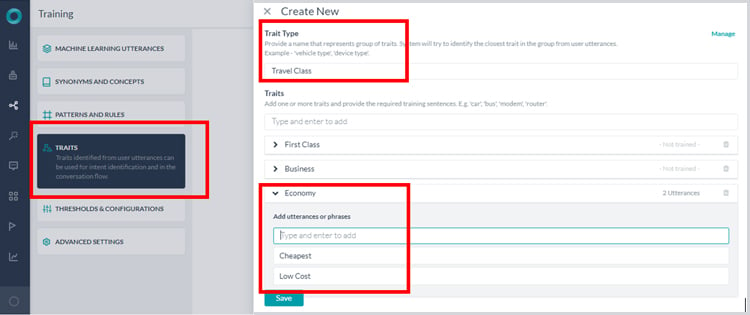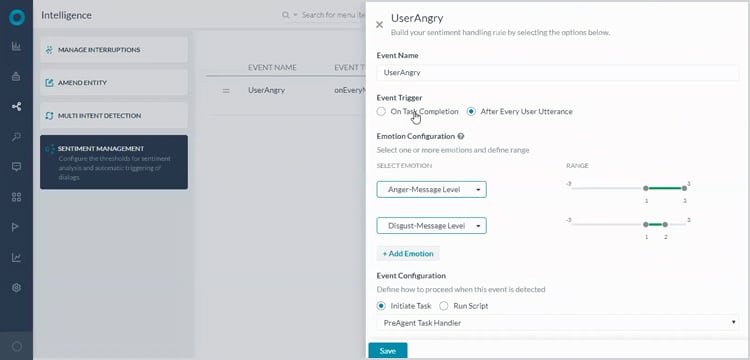Chatbots are changing the way users interact with enterprises. The users want their queries to be resolved not just in a lesser time but also accurately. They even expect to get the actions performed on behalf of them. This makes the use of chatbots indispensable for enterprises in the near future. Having said that, many companies are still apprehensive of the use of chatbots. The risk lies in the inability of the chatbot to replicate humanesque conversation styles. Delay and flaws in the response might lead to customer churns and lower customer satisfaction.
Kore.ai has always focused on achieving customers delight through the exceptional AI/ML algorithms used in the platform. It has strived to enhance the NLP capabilities of the bots platform enabling the bots to understand the colloquial language of the users.
The Kore.ai Bots Platform version 7.0. has the following new and improved features to enhance the user’s experience and improve bot development life cycle.
Also Read: Kore.ai Virtual Assistant Platform Release 7.3. We Got What You Asked For! |
Traits
Kore.ai introduces a new NLP feature called Traits. Traits are specific entities, attributes or details that the users express in their conversations. In natural conversations, it is quite common for users to provide background information while describing a specific scenario. Traits as a feature uses this background information to identify the intent and accordingly drives the conversational flow. This will further enhance the experience of the end user while conversing with the bots.
In order to configure the feature, the developers have to define the traits, add a rule for the trait and add transition/identification condition.
Use Case
Book a Flight bot might have an added requirement to book a flight based on the cost preference.

This requirement of fetching flight details based on cost be achieved by:
- adding a Trait Type called “Travel Class” with Trait “Economy” trained with the utterance “Low Cost”
- adding a Rule for “book flight” to be triggered in the presence of Economy Trait
- add transition condition in case Trait Economy is present in the context
The snapshot below shows how a trait can be defined within a trait type. In this case, there are 3 types of traits (Business, Economy and First Class) within a Trait Type named Travel Class. The Economy Trait has been trained with the utterances such as “Cheapest” and” Low Cost”

Sentiment-based event management
Newly introduced bot level sentiment-based event management feature will now allow the bots to intelligently identify the changes in user’s conversation tone and automatically perform actions matching the mood of the user.
Also Read: Kore ai Virtual Assistant Platform v7.2 : Design and Build Conversational Experiences That Matter |
The developers now can do away with writing the scripts and can directly define rules to trigger events based on the tone level and the threshold values.

Depending upon the mood of the user, the bot can be configured to act. For example, if the user is angry or disgusted, then the bot would typically transfer the conversation to a live agent.

The Natural Language Processing (NLP) interpreter parses user utterances for specific words and phrases, and then provide an average tone score based on the connotation, word placement, and any added modifiers. This tone score can be used to trigger appropriate events that would be in sync with the user emotion or mood. The triggering of the events can be done on task completion or after every user utterance.
Enhanced Context Management
The context management feature is now better than ever. The bots now can carry the context across intents not just for dialog tasks but also for knowledge collection.
The follow-up intents now can be configured across knowledge collection intents and dialog task intents. Besides this, the context management is further improved to handle timeouts against conversations on hold. Now, if the user comes back in another session asking about the old intent, or context from the previous sessions, then the bot shall continue with the old intent instead of asking for a new one.

In the above conversation, the bot will understand that “apply” is in the context of “credit card”. The Bot should not be asking the user whether they would like to apply for a credit card or a debit card.
As an enhancement to this feature, the context from the previous intent, FAQ – credit card annual charges, shall be passed to the intent, Apply for a card. Thus, the experience of the user gets enriched since they do not have to repeat the context again.
Also Read: Kore.ai Bots Platform Version 7.1 unveils Developer and User Friendly Features |
Additional Language Support
Kore.ai bot’s platform has been supporting more than 12 languages before. In this release, the platform is further upgraded to make the bots more polyglot by adding Russian, Polish and Ukrainian languages. The bots can now be created, published in these new languages and it can also comprehend these new languages.
Additional Channels Support
The platform now supports WhatsApp for Business and on-premise version of Skype for Business. The bots now can be accessed by the users via these channels. Besides this, the platform now supports rich text media messages with images, quick replies and rich card carousels on SMS channel using RCS Business Messaging. Apart from this, the Open source enterprise messenger Mattermost is also supported in the new version.
Addition of New Entity Type
Remote Lookup is a new entity type added in this version. It has been introduced with an ability to call remote services to populate entity values. This entity can be used to perform custom validations through a service call to external systems and then extract the entity value by mapping the response to ‘List of values’ entities.
Other Enhancements
- The bots platform version 7.0 now has its own algorithm for identifying the end-user language. This algorithm replaces the Google language service and can also be deployed on-premise.
- A search in answer configuration has been added in the platform using which the identification of the FAQs can be done by matching the user inputs against the answer section. This will be applied only if no FAQs are identified from questions.
- The developers can now enable multiple Webhook channels to their Bot, once added the Webhook channel will not be disabled from the Channel list and they can use the same process to enable another Webhook channel with a different name.
- The functionality of Meta Tags is now improved. This will allow for adding tags from the Bot builder UI for each node and use these tags as filters in insights and metrics pages.
- Changes have been made to conversation flow/user journey analytics interactive report for better user experience.
- Significant improvements have been made to monitoring and management capabilities for the on-premise version of the software.
- Composite Entities have been enhanced with support for Entity Patterns in addition to Composite Patterns.
- The platform now provides integration with Blue Prism RPA and LiveBank SDKs.
- Improvements and enhancements have been made to Knowledge Collection, Knowledge Extraction, Bot Analytics, and NLP Test & Train.
In addition, the platform has a host of minor enhancements and bug fixes included in this release. For detailed information related to Kore.ai Platform v7.0 release, refer product documentation.
If you have any feedback, ideas for new features, or if you wish to see a demo of the platform, please write to us at info@kore.com







